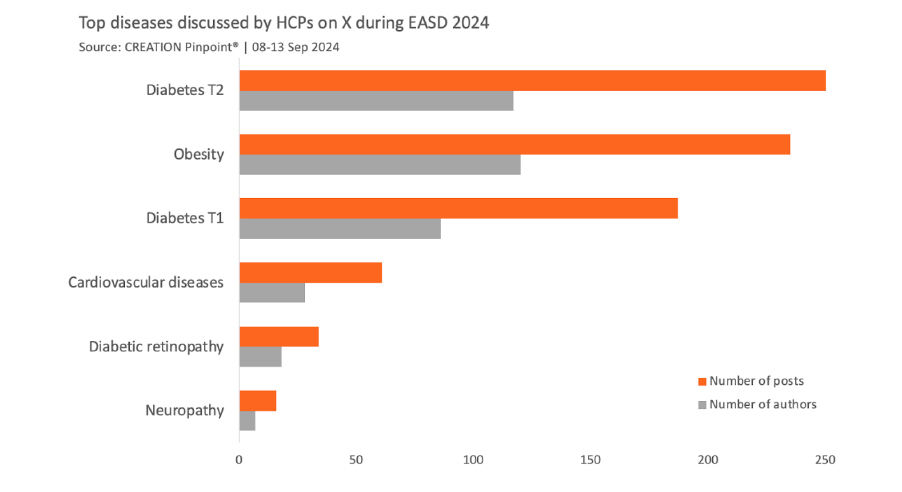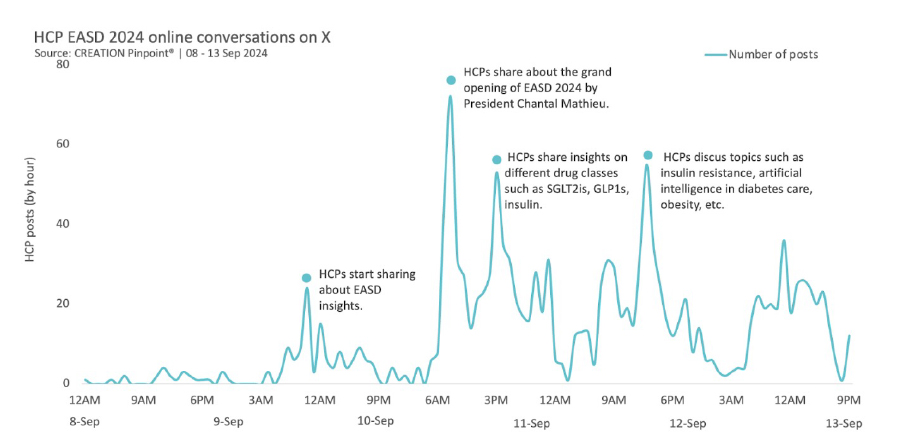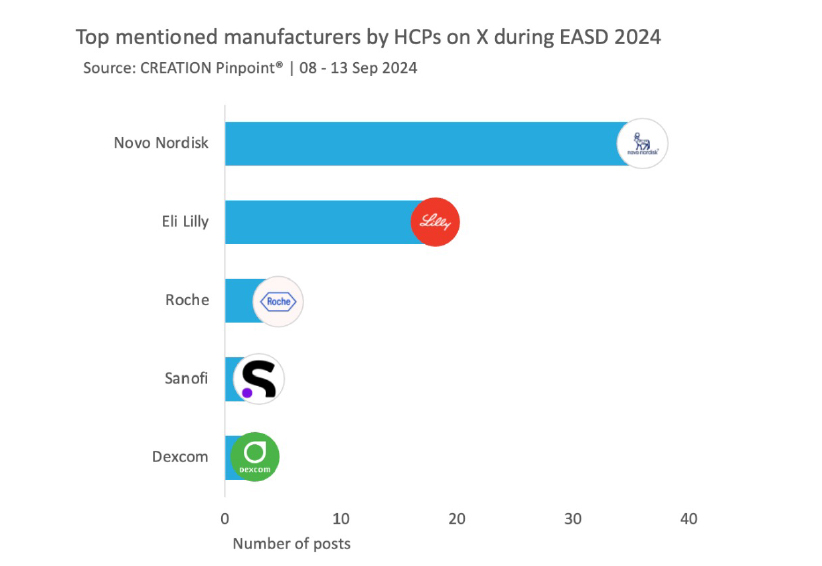Unpacking EASD 2024: Key themes, topics, and influencers

This September, Madrid played host to the 60th Annual Meeting of the European Association for the Study of Diabetes (EASD). More than 12,300 participants from over 130 countries attended the conference, both online and in person, to present on and hear the latest results from basic and clinical research into diabetes and its associated diseases.
Amidst the breadth of discussion at the conference, as with many of the largest healthcare congresses, it can often be difficult to distil which presentations, trial data, and treatment developments drew the most attention from attendees. This was certainly the case during EASD 2024, which included more than 1,000 sessions, lectures, seminars, and presentations throughout its five-day programme.
An analysis of the social media activity of healthcare professionals (HCPs) attending the conference, though, offers an opportunity to evaluate the moments that proved especially engaging. These unprompted conversations act as a tool with which to gain insight into the attitudes, perspectives, and concerns of those on the frontlines of diabetes care.
During EASD 2024, we analysed the contents of 1,784 posts on X (formerly Twitter) and 60 LinkedIn posts generated by 350 individual HCPs. Social media activity ranged from reconnecting with colleagues and praising presentations to contributing thoughts and reflections on the most significant discussions in the diabetes disease and treatment space.
Key Themes
Perhaps unsurprisingly, diabetes (both type 1 and type 2) was the most discussed disease, mentioned by over 200 HCPs in more than 400 posts. Conversations were not, however, limited to general commentary on the disease - nor were they the only diseases discussed throughout the conference. In fact, others including obesity, cardiovascular disease, MASLD, and neuropathy also attracted attention among healthcare professionals online.

Within each of these disease spaces, HCPs considered and explored a wide range of more specific topics and developments. These included, for example, comparisons of insulin treatments in type 2 diabetes, evaluations of the importance of personalised care in disease management, examinations of the impact of maternal stress in pregnancy and type 1 diabetes in offspring, and considerations of the role of GLP1-RAs in cardiovascular risk reduction and obesity.
The breadth of subject areas that HCPs used social media to praise, critique, and discuss throughout EASD 2024 underlines the increasingly influential role that social media is playing as a vehicle for information distribution in healthcare.
Digging deeper: HCPs online, before, and during the conference
As we often find in our analyses, healthcare professionals were already posting on social media in anticipation of the conference ahead of its official opening. In total, we identified 24 individual HCP posts discussing EASD 2024 in the lead up to 9th September.
By the first day of the conference, many HCPs had begun sharing their experiences from Madrid, posting photos and highlighting key sessions.
Early HCP discussions covered a variety of topics. One that drew several HCP mentions, for example, was the SCORE2-Diabetes algorithmic tool, which provides personalised 10-year cardiovascular risk estimates in the hope of enabling earlier intervention and better disease management. Others that attracted attention were presentations on targeting metabolic dysfunction–associated steatotic liver disease (MASLD) for cardiovascular disease (CVD) prevention, and on the impact of body weight variability on cardiovascular risk.

On 10th September, we witnessed a notable spike in online conversations, driven by three key sessions. The Claude Bernard Lecture, delivered by Professor Roy Taylor, generated the most engagement, with 79 posts from HCPs. Online healthcare professionals took to social media to praise Professor Taylor’s “excellent” lecture, with one describing the presentation as “brilliance at its best, with humility.”
Following closely in overall mentions came Chantal Mathieu's Presidential Address, which attracted 67 posts. The third most-discussed session among HCPs online was the Diabetes India Symposia, which sparked discussion in 42 HCP posts.
A diabetologist from India, Dr Amit Gupta, captured the day as follows: "Day 2 of #EASD2024 was dominated by Roy Taylor’s powerful insights on diabetes remission & Chantal Mathieu’s inspiring presidential address. Feeling proud to see the Diabetes India Symposia standing out after the masterly lectures."
While sharing research updates throughout the conference, HCPs frequently tagged the conference’s own online accounts, such as @EASD and @EASD e-learning. Among the most shared posts from HCPs when mentioning EASD was a post by Dr Daniel Drucker sharing details of the SCALE Kids trial, which found that, among children aged six to 12 with obesity, treatment with liraglutide for 56 weeks plus lifestyle interventions resulted in a greater reduction in BMI than placebo. The trial itself was discussed in 20 HCP posts. Elsewhere, developments in continuous glucose monitoring attracted 28 HCP posts, while studies on insulin delivery methods were discussed in 53 posts.
The most influential healthcare professionals
The EASD Conference this year was demonstrably one with worldwide influence and interaction. Our analysis found that healthcare professionals from the United Kingdom and India led social media activity this year, with the former contributing more than a quarter of the overall online conversation, and the latter accounting for 15%.
Four of the top ten most active HCPs throughout the conference were from India, with Dr Harpal Malhotra and Dr Shashank Joshi leading the pack with 155 and 140 original posts respectively. Of the remaining top ten, HCPs came from Argentina, Canada, and Denmark - a testament to conference’s international reach.
Peer to peer acknowledgement among HCPs was also particularly prominent during the conference. Dr Shashank Joshi, who led the presentation on targeting MASLD for CVD prevention, proved the most mentioned among fellow HCPs this year, followed by Dr Amit Gupta.
The post that HCPs shared the most during the conference was a post by The Lancet sharing a link to an article entitled: “Muscle matters: the effects of medically induced weight loss on skeletal muscle”. It was shared by 61 healthcare professionals. This was followed closely by a study from the New England Journal of Medicine on insulin efsitora alfa, which received 40 shares.
Most mentioned pharmaceutical companies
HCP conversations naturally also extended to mentions of particular pharmaceutical manufacturers. Through the conference, Novo Nordisk was the most mentioned by HCPs, mainly stemming from discussion of the Novo Nordisk Foundation Future Leaders Award and sharing the company’s EASD updates. In second place was Eli Lilly, with 18 HCP mentions, primarily focusing on the future of diabetes management and weight control.

The social media conversations during EASD 2024 offer a unique opportunity to identify exactly which aspects of diabetes care are attracting attention from those on the frontlines of its delivery. Importantly, though, we are also able to identify those healthcare professionals most influential in disseminating the most significant findings to a wider healthcare audience - offering another avenue by which knowledge can be transferred to drive better health outcomes.











